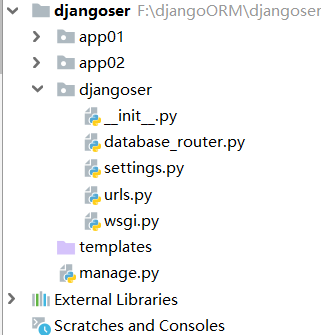1.项目目录
在存在两个app的时候使用两个数据

2.model类
app02/models.py
在使用多数据库的时候,我们要到每个表的下面使用[app_label=app的名字],示例如下
class Publish(models.Model):
name=models.CharField(max_length=32)
email=models.EmailField()
def __str__(self):
return "app02 %s" % self.name
class Meta:
#app的名字
app_label = 'app02'
3.settings的写法
DATABASES = {
'default': {
'ENGINE': 'django.db.backends.mysql',
'NAME': 'orm', ## 数据库名称
'USER': 'root',
'PASSWORD': '123456', ## 安装 mysql 数据库时,输入的 root 用户的密码
'HOST': '127.0.0.1',
},
'mysql02': {
'ENGINE': 'django.db.backends.mysql',
'NAME': 'orm02', ## 数据库名称
'USER': 'root',
'PASSWORD': '123456', ## 安装 mysql 数据库时,输入的 root 用户的密码
'HOST': '127.0.0.1',
},
}
# 多数据库连接池
DATABASE_ROUTERS = ['djangoser.database_router.DatabaseAppsRouter']
# 配置app与之相对应的连接池
DATABASE_APPS_MAPPING = {
'app01': 'default',
'app02': 'mysql02',
4.在同级目录下添加database_router.py
from django.conf import settings
DATABASE_MAPPING = settings.DATABASE_APPS_MAPPING
class DatabaseAppsRouter(object):
"""
A router to control all database operations on models for different
databases.
In case an app is not set in settings.DATABASE_APPS_MAPPING, the router
will fallback to the `default` database.
Settings example:
DATABASE_APPS_MAPPING = {'app1': 'db1', 'app2': 'db2'}
"""
def db_for_read(self, model, **hints):
""""Point all read operations to the specific database."""
if model._meta.app_label in DATABASE_MAPPING:
return DATABASE_MAPPING[model._meta.app_label]
return None
def db_for_write(self, model, **hints):
"""Point all write operations to the specific database."""
if model._meta.app_label in DATABASE_MAPPING:
return DATABASE_MAPPING[model._meta.app_label]
return None
def allow_relation(self, obj1, obj2, **hints):
"""Allow any relation between apps that use the same database."""
db_obj1 = DATABASE_MAPPING.get(obj1._meta.app_label)
db_obj2 = DATABASE_MAPPING.get(obj2._meta.app_label)
if db_obj1 and db_obj2:
if db_obj1 == db_obj2:
return True
else:
return False
return None
def allow_syncdb(self, db, model):
"""Make sure that apps only appear in the related database."""
if db in DATABASE_MAPPING.values():
return DATABASE_MAPPING.get(model._meta.app_label) == db
elif model._meta.app_label in DATABASE_MAPPING:
return False
return None
def allow_migrate(self, db, app_label, model=None, **hints):
"""
Make sure the auth app only appears in the 'auth_db'
database.
"""
if db in DATABASE_MAPPING.values():
return DATABASE_MAPPING.get(app_label) == db
elif app_label in DATABASE_MAPPING:
return False
return None
# for Django 1.4 - Django 1.6
def allow_syncdb(self, db, model):
"""Make sure that apps only appear in the related database."""
if db in DATABASE_MAPPING.values():
return DATABASE_MAPPING.get(model._meta.app_label) == db
elif model._meta.app_label in DATABASE_MAPPING:
return False
return None
# Django 1.7 - Django 1.11
def allow_migrate(self, db, app_label, model_name=None, **hints):
print(db, app_label, model_name, hints)
if db in DATABASE_MAPPING.values():
return DATABASE_MAPPING.get(app_label) == db
elif app_label in DATABASE_MAPPING:
return False
return None
5.执行命令
python manage.py makemigrations --database指定要加载那个modles python manage.py migrate --database=app02 #这样生成的数据库前缀app02_xxx